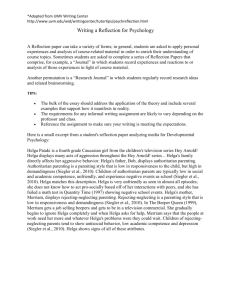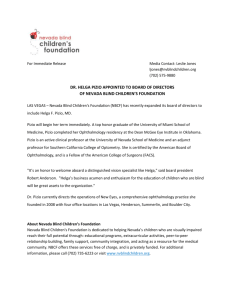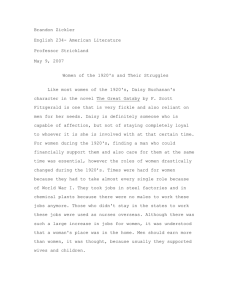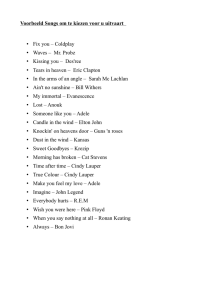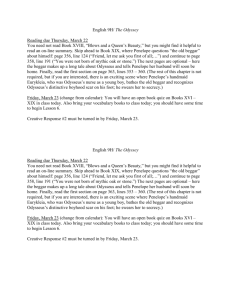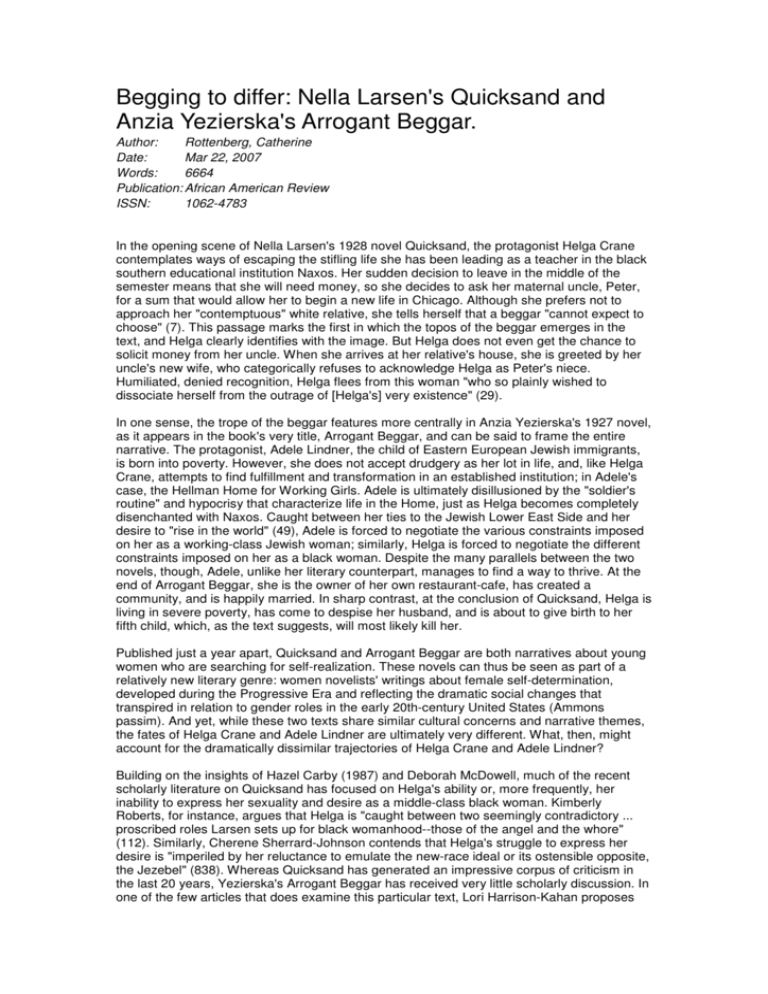
Begging to differ: Nella Larsen's Quicksand and
Anzia Yezierska's Arrogant Beggar.
Author:
Rottenberg, Catherine
Date:
Mar 22, 2007
Words:
6664
Publication: African American Review
ISSN:
1062-4783
In the opening scene of Nella Larsen's 1928 novel Quicksand, the protagonist Helga Crane
contemplates ways of escaping the stifling life she has been leading as a teacher in the black
southern educational institution Naxos. Her sudden decision to leave in the middle of the
semester means that she will need money, so she decides to ask her maternal uncle, Peter,
for a sum that would allow her to begin a new life in Chicago. Although she prefers not to
approach her "contemptuous" white relative, she tells herself that a beggar "cannot expect to
choose" (7). This passage marks the first in which the topos of the beggar emerges in the
text, and Helga clearly identifies with the image. But Helga does not even get the chance to
solicit money from her uncle. When she arrives at her relative's house, she is greeted by her
uncle's new wife, who categorically refuses to acknowledge Helga as Peter's niece.
Humiliated, denied recognition, Helga flees from this woman "who so plainly wished to
dissociate herself from the outrage of [Helga's] very existence" (29).
In one sense, the trope of the beggar features more centrally in Anzia Yezierska's 1927 novel,
as it appears in the book's very title, Arrogant Beggar, and can be said to frame the entire
narrative. The protagonist, Adele Lindner, the child of Eastern European Jewish immigrants,
is born into poverty. However, she does not accept drudgery as her lot in life, and, like Helga
Crane, attempts to find fulfillment and transformation in an established institution; in Adele's
case, the Hellman Home for Working Girls. Adele is ultimately disillusioned by the "soldier's
routine" and hypocrisy that characterize life in the Home, just as Helga becomes completely
disenchanted with Naxos. Caught between her ties to the Jewish Lower East Side and her
desire to "rise in the world" (49), Adele is forced to negotiate the various constraints imposed
on her as a working-class Jewish woman; similarly, Helga is forced to negotiate the different
constraints imposed on her as a black woman. Despite the many parallels between the two
novels, though, Adele, unlike her literary counterpart, manages to find a way to thrive. At the
end of Arrogant Beggar, she is the owner of her own restaurant-cafe, has created a
community, and is happily married. In sharp contrast, at the conclusion of Quicksand, Helga is
living in severe poverty, has come to despise her husband, and is about to give birth to her
fifth child, which, as the text suggests, will most likely kill her.
Published just a year apart, Quicksand and Arrogant Beggar are both narratives about young
women who are searching for self-realization. These novels can thus be seen as part of a
relatively new literary genre: women novelists' writings about female self-determination,
developed during the Progressive Era and reflecting the dramatic social changes that
transpired in relation to gender roles in the early 20th-century United States (Ammons
passim). And yet, while these two texts share similar cultural concerns and narrative themes,
the fates of Helga Crane and Adele Lindner are ultimately very different. What, then, might
account for the dramatically dissimilar trajectories of Helga Crane and Adele Lindner?
Building on the insights of Hazel Carby (1987) and Deborah McDowell, much of the recent
scholarly literature on Quicksand has focused on Helga's ability or, more frequently, her
inability to express her sexuality and desire as a middle-class black woman. Kimberly
Roberts, for instance, argues that Helga is "caught between two seemingly contradictory ...
proscribed roles Larsen sets up for black womanhood--those of the angel and the whore"
(112). Similarly, Cherene Sherrard-Johnson contends that Helga's struggle to express her
desire is "imperiled by her reluctance to emulate the new-race ideal or its ostensible opposite,
the Jezebel" (838). Whereas Quicksand has generated an impressive corpus of criticism in
the last 20 years, Yezierska's Arrogant Beggar has received very little scholarly discussion. In
one of the few articles that does examine this particular text, Lori Harrison-Kahan proposes
that Adele, like Yezierska's other heroines, is represented as a hybrid character, caught
between "white aspirations and ethnic loyalties" who is not fully assimilated at the end (432).
Drawing on this recent criticism, my comparative approach in this paper focuses on aspects
of Larsen's and Yezierska's texts that have yet to be explored. More specifically, in what
follows, I investigate the trope of the beggar, which surfaces at various and crucial moments
in these two novels, to argue that although Quicksand and Arrogant Beggar both invoke
images of begging and beggary, there is a profound difference in the ways that Larsen and
Yezierska depict their protagonists' relationship to this trope. It is this difference, I propose,
that can help account for the radically divergent trajectories of Adele Lindner and Helga
Crane, and, perhaps more importantly, can provide a way of conceptualizing the dissimilar
"racial" positions and identifications of African American and Jewish American women during
the early twentieth century. (1) My discussion, therefore, will not revolve around the important
question of Helga's sexuality; and while Harrison-Kahan's claim regarding Adele's hybridized
identity is well taken, I use the trope of the beggar to argue that Yezierska's text actually
gestures toward the way Jewishness and whiteness were being reconfigured as more and
more compatible with one another. (2)
Are You a Beggar?
While living in Denmark with relatives, Helga Crane receives an invitation to the wedding of
her friend Anne. Initially, she refuses to embark on the journey. Her response is forceful: "Go
back to America, where they hated Negroes! To America, where Negroes were not people.
To America, where Negroes were allowed to be beggars only, of life, of happiness, of
security. To America, where everything had been taken from those dark ones, liberty, respect,
even the labor of their hands. To America, where if one had Negro blood, one mustn't expect
money, education, or, sometimes, even work whereby one might earn bread" (82; emphasis
mine).
Having already identified herself as a beggar when back at Naxos, here in Denmark Helga
broadens her scope to include all Negroes in this identification.
To be a "Negro" in America is to be a mendicant, not only in terms of money, but also in terms
of life, happiness, security, and liberty. Negroes, we are told, are non-people. Their livelihood,
self-respect, and recognition depend on the sufferance of others. Helga draws a clear
connection between Negroes and beggars, intimating that "blackness," or one drop of "Negro
blood," has necessarily entailed some form of beggary in the United States. Helga, therefore,
emphatically decides to stay in Denmark as well as to stop dwelling on the whole affair of
race. Nevertheless, she ultimately cannot help herself from thinking about her friend Anne or
Anne's prospective husband, and the question of being a Negro in America continues to
haunt her.
A few days following the arrival of Anne's invitation, Helga attends the "great Circus" with a
prospective husband and some Danish acquaintances. After watching a minstrelsy act
performed by two black American men, Helga is discomfited by the "avidity" with which the
Danes "drank it in." She feels as if "something" in her has been exposed, some characteristic
that Negroes possess but that "the pale pink and white people among whom she lived" did
not (8283). It is at this point in her ruminations that the topos of beggary reappears. Whatever
this "something," this characteristic that has been exposed is, Helga suspects that no
Negroes and no Americans admired "it." Why else, she asks herself, do American Negroes
constantly imitate "traits not their own?" "Why their constant begging to be considered as
exact copies of other people? Even the enlightened, the intelligent [American Negroes]
demanded nothing more" (83). Although Larsen uses begging here in a slightly different
sense, the connotation is similar. It seems that to gain any kind of respect--even self-respect-Negroes had to beg; they had to plead even "to be considered as exact copies" of other
people, that is, of Whites. In Larsen's fictive early 20th-century US, beggary is closely linked
to blackness: as a black American, one is always dressed in rags and tags, literally or
metaphorically.
In stark contrast to Helga Crane, Adele Lindner resists identifying as a beggar at almost every
turn in Arrogant Beggar. One such occasion occurs when she catches a glimpse of her
benefactress, Mrs. Hellman, wiping off a kiss Adele has impetuously given the wealthy
patroness. Adele is mortified, and asks herself why the wealthy should have "the glory of
giving" while the poor, like herself, have the "shame of taking like beggars the bare
necessities of life?" (49; emphasis mine). In other words, Adele wonders why poor people
should be made to feel like beggars when they are merely trying to find ways of obtaining the
necessities of life. Adding "like" before the word beggar, however, provides a distance
between Adele and the identity of beggar. While Adele appears to have no difficulty
identifying as a poor woman, there is an implicit refusal to identify as a beggar.
Another important incident in which the trope of beggar remerges on the narrative level in
Yezierska's text takes place subsequent to Adele's disillusionment with life at the Hellman
Home for Working Girls. Adele has been asked to speak during the Board of Directors' annual
meeting due to her model behavior; but midway through her prepared speech, she bursts into
a tirade of recrimination, anger, and defiance. Adele accuses the women who run the Home
of hypocrisy, of treating the workers like beggars. In her room a little later, still fuming, Adele
thinks of all the things she did not say, such as, "You've shown me up for a beggar! So I've
shown you up for the humbugs you are!" (87). The wealthy women of the Home have tried to
impose the identity of beggar on the working girls, but again Adele abjures this identity by
referring to the Directors as humbugs, that is, as liars and deceivers. (3)
Yezierska clearly positions her protagonist on the margins of US society: Adele is a poor
Jewish woman struggling to make ends meet. Yet Adele consistently repudiates the identity of
beggar, which she--like Helga--understands to be a sort of non-person, one who is dependent
on the whims of others for their charity. She comes to despise the "cringing, truckling" that
she feels forced to perform to stay in the good graces of Mrs. Hellman and her likes. The
question then becomes what enables or encourages Adele to reject the category of beggar
and assert that she will "cringe and flatter no longer" (88), while Helga not only personally
identifies as a beggar but also links all black Americans with beggary? How might we explain
the two protagonists' very different relationship to the figure of the beggar? In other words,
what might have prompted Larsen to create a protagonist who cannot or will not refuse an
identification with beggary, while Yezierska presents a protagonist who triumphantly distances
herself from this identification?
Black Identification
To begin answering these questions, I return for a moment to the crucial scene in which
Helga watches the minstrelsy show at the "Circus" with great discomfort. As already
mentioned, after she sees the dancing and cavorting black men, Helga feels as if "something"
in her has been exposed. The "something" that Larsen evadingly refers to in the text can
easily be read as a racialized essence that ties Helga to the dancing men, that is, as an
inherent attribute that all Negroes possess. Helga's discomfort can consequently be read as a
recognition that she, too, possesses this attribute and a fear that the Danish spectators will
recognize (or have already recognized) the similarity between her and the performing men.
While such a reading is certainly plausible, Larsen's "something" should, I believe, be
problematized and read not as an essential attribute that all Blacks share but as the "shame"
that has been tied to the compelled identification with blackness. After all, in a 1929 book
review, Larsen had dismissed all of the "twaddle concerning the inherent qualities of the
Negro" (qtd. in T. Davis 304). Accordingly, I contend that, to gain insight into the significance
of the topos of beggar in Quicksand, this "something" should not be read as a common and
innate characteristic that links black Americans together, but rather as a forced identification
with blackness, a socially constructed but nonetheless powerful category of identity that has
been coded as beggarly and undesirable by a white supremacist society. (4)
Following Michel Pecheux, I understand identification as being constituted, initially, by the
primary address or interpellation through which a subject is initiated into the dominant social
and discursive order. This preliminary interpellation both inaugurates the subject as a subject
and imposes an initial identification with specific identity categories such as gender, class,
race, or ethnicity; this interpellation, in other words, entails an enforced primary identification.
Yet it is important to underscore that not all identifications are equal or carry the same
valence, and although a subject's identification is always shaped and mediated by the primary
address, identification is never determined once and for all by this interpellation. (5)
Helga's identification with blackness and her relationship to other black Americans is
represented in the text as complex and ambivalent--a mixture of positive attachment and
contempt. At times her contempt is depicted as overriding her love, as when Larsen has her
protagonist describe Harlem as a "hateful place where one lived in intimacy with people one
would not have chosen had one been given a choice" (53). Why, Helga asks herself in
despair, had she been "yoked to these despised black folk?" (55). On other occasions,
Helga's positive attachment to blackness and to the despised black folks trumps her hostility.
After returning to the US from Denmark, Helga wonders how she could have thought that
going to another country would liberate her from the ties "which bound her forever to these
mysterious, these terrible, these fascinating, these lovable, dark hordes" (95; emphasis mine).
But no matter which pole of the ambivalence is uppermost at any given moment, Larsen
portrays Helga's identification as a black woman and thus her tie to other black Americans as
something over which Helga has little control and as a bond that is not and cannot be chosen.
Thus, through her dramatization of Helga's inability to escape her identity as a black woman
during her journey to Denmark, Larsen is gesturing not towards some essentialist conception
of race, but rather to a crucial aspect of the way race identification has operated as a
mechanism of control. In the early 20th-century US, subjects born with "one-drop" of "black"
blood were compelled by the dominant white racist society to identify as black (F. Davis 12).
And due to reigning white supremacist norms, "Blacks" were construed by hegemonic society
as non-subjects who had, in effect, to beg for recognition as subjects. As Nella
Larsen underscores in her text, the identification with blackness was constituted by the
dominant US society as an identification with beggary and non-personhood.
The distinction Larsen makes between the pale pink people and the "something" that
connects Helga to the black minstrel performers is not, however, about identification per se,
but rather the valence of identification. After all, as I argued above, all subjects are compelled
to identify in certain ways; therefore, compulsion as such does not constitute the distinction
between identifying as black and identifying as white; identifying as white has never been a
matter of choice either. Accordingly, the difference between identifying as white and
identifying as black is that the former do not experience the compulsion to identify as "white"
as a compulsion--at least not in the same way--because whiteness in the US has been the
normative, desirable, and privileged form of identification.
Larsen's description of the black minstrelsy singers, for instance, is laced with images of
brutality, thus symbolically (re)enacting the way that blackness was coded as undesirable by
the white dominant society in the US during the 1920s: "[P]ounding their thighs, slapping their
hands together, twisting their legs, waving their abnormally long arms, throwing their bodies
about" (83; italics added). The description is not only meant to provide a spectacle, but its
hyperbole evokes images of debasement as well as violence. Subjects are compelled to
identify in certain ways, but Larsen's description of this performance also draws attention to
the violent means used in the US to ensure that black subjects did not transgress the
boundaries of race identification (Rottenberg 2004). Interestingly, however, Helga reveals that
the Danes rate the identification with blackness as a precious thing--precious because rare--a
thing to be enhanced; but in America, she continues, no one admires it.
Helga's ruminations about the "something" that ties her to the men on the stage, as well as
her discomfort at the Danes' reaction to the show, can be read as a dramatization of the way
that identification operates as a technology of control. (6) Helga is disconcerted by the
realization that she is indeed connected--inextricably--to these men due to a shared, imposed,
and "undesirable" identification. The move to Denmark has not allowed her, as she had
hoped, to escape the "bonds" that tie her to these black performers and to a metaphoric
beggary. Perhaps she can also be read as understanding, on some level, that the Danes
have turned this compelled identification into an essential characteristic, one they think should
be valued.
This realization shakes her, since one of the major reasons Helga left US was to gain a
feeling that she belonged to "herself alone" and not to a "race" (64). But from the very
beginning of her stay in Denmark, Helga is exoticized due to her dark complexion; she is
turned into a curio, a "peacock" (73), and is appreciated for her difference, not as an
individual but as a representative of a strange and foreign species. The Danes also ensure
that racial identifications are maintained, but rather than coding blackness as debased, they
seem to code it as highly desirable because rare and exotic. In fact, Helga's relatives, the
social climbing Dahls, desperately want Helga to marry the famous painter, Axel Olsen. In the
United States, miscegenation was, at very best, tolerated; it certainly would not have been
encouraged by the upwardly mobile white middle class. This encouragement perhaps points
to an interesting difference in the racial landscape of the two countries.
But the Danish positive re-evaluation of blackness, Helga also begins to realize, merely
becomes a fetishization, a way of maintaining difference while disavowing how difference has
operated to produce and maintain inequality. Had Helga married Axel, she would most likely
have become a showcase wife--a decoration (73). Valorizing racial difference is a dangerous
game, especially when such valorization merely embraces and lionizes the attributes that
white supremacist society has ascribed to this difference. Therefore, if Helga's discomfort at
the Circus is read as a double recognition, then the fascinating scene in which Helga watches
the minstrelsy show gestures to the way that identification helps constitute subjectivity by
compelling subjects to identify in prescribed ways, as well as gesturing to the problem with
merely reversing a given identification's valence. After all, identification is carefully policed
and enforced only in those instances where existing power structures are dependent on
differentiating subjects in specific ways; merely reversing the value of race identification in no
way questions why subjects are differentiated according to categories such as "race" in the
first place.
Jewish Identification
Helga Crane first identifies herself as a beggar and then moves to include all African
Americans in this identification. Adele Lindner refuses to identify herself as a beggar, and
then moves to distance the other working girls in the Hellman Home from actual beggary.
Describing the typical immigrant working girl Adele tells the reader: "That actress. How she
came fawning, wheedling, begging Mrs. Hellman to save her life with a hundred-dollar loan.
As soon as she landed a job--no more use for Mrs. Hellman" (60; emphasis mine). The
working girl only acts the part of beggar to get a head start in life; begging is not a state of
being for the young working girls; if anything, it is a performance to be staged as a way of
escaping the terrible poverty of the tenements. For Yezierska, Adele and the working girls are
emphatically not real beggars.
It is crucial to note that the Home for Working Girls in Arrogant Beggar is a meeting place for
poor people from all immigrant groups: Italians, Irish, Jews, and Poles. At one point in the
novel, as the girls are bickering during dinner, someone comments that the Home is like a
"League of Nations: Kikes, Wops, Micks, and Polacks. Only thing missing's a Chink to make it
perfect" (22). Although this comment is made during a raucous and not altogether amiable
dinner, the presentation of these girls--from all of the different groups--can be read as
constructing America in a positive light, as a place in which all groups come together, argue,
but ultimately live side by side. The entrance of Miss Simmons, the matron of the Home,
focuses the workers' attention on a common enemy, and by the end of the evening they are
all dancing together to jazz tunes. But what is particularly interesting is that while the "Chink"
is included as part of the League of Nations--albeit as an absent presence and thus perhaps
as a less desirable fellow countrywoman--African Americans are totally absent from the
scene, that is, except metonymically in the form of jazz.
Later in the novel Adele is forced to train as a domestic because she has been laid off and is
unable to pay the rent for her room in the Home. The rest of the working girls in the institution
look down on housework since domestic work is considered to be "servants' work," degraded
and degrading. (7) Adele reveals that "Even in our worst poverty in Poland none of our people
had ever been servants. Tailors, storekeepers, but never a servant" (37). And when Adele's
roommates find out about her new position, they are surprised and mock her, making "little
clicking sounds between their tongue and teeth." But, as is her wont, Adele refuses to bow to
their taunts, and instead informs her roommates that she is neither "begging" nor asking for
charity: "I'll show you in America all work is respectable. In America, dish-washers and hodcarriers can also be citizens with the same rights as the President" (39). Adele insists that her
new work is respectable, once again disavowing the status of beggar, and never doubting for
a moment that she is an American who deserves the same rights as the President (11). For
Adele, there is absolutely no link between Jewishness and beggary.
The Black-White Divide
If it is true that the very intelligibility of the dominant racial landscape in the early 20th-century
US depended on producing "whiteness" as the only desirable race while maintaining the
black-white divide as the central racial divide, then certain aspects of the topos of beggar in
Arrogant Beggar and Quicksand begin to make sense. (8) A "black" subject was not able to
identify as "white" (or if s/he did, that is, if s/he attempted to pass as white, it was constituted
as a transgression), and yet that same subject was urged and compelled to desire to live up
to norms of whiteness. Larsen's descriptions of the "successful" Blacks in Quicksand,
characters like Anne Grey, illustrate this division between identification and the desire to
emulate whiteness. Even though Anne Grey cannot identify as white, she mimics the clothes
and manners of the dominant white middle class (48). She also shows a disdainful contempt
for the "songs, the dances, and the softly blurred speech" of the Negro folk (48). Thus, one of
the few ways to access sites of power for black Americans was to emulate norms that were
historically linked to whiteness. While they were encouraged to emulate these norms, African
Americans were compelled to continue identifying as black. And no matter how Blacks coded
their identification with blackness (whether as something to be proud of or as something to be
ashamed of), this identification was coded as undesirable by the dominant social order.
As Larsen's narrative suggests, even the likes of Anne Gray are ultimately beggars in the US.
In America, Helga asserts, Negroes sometimes talked loudly of enhancing "racial
characteristics," yet in "their hearts they repudiated it.... They didn't want to be like
themselves. What they wanted, asked for, begged for was to be like their white overlords"
(74; italics added). The desire to be white, however, must be understood in relation to the way
that positive power--in the Foucauldian sense--operates. If the dominant society privileges
certain attributes, then it must also encourage subjects to desire and strive to embody them. It
can and does attempt to bar certain subjects from accessing privilege and positions of power
through race differentiation and classification or, in other words, compelling race identification,
but it cannot completely control the effects of its own discourse. So long as blackness is
coded as undesirable by white supremacist regimes, only those black-identified subjects who
strive to embody attributes associated with whiteness will gain admittance to hegemonic sites
of power.
This desire to be white, however, must also be understood in the context of early 20th-century
conceptions of Americanness. This era was a time in which, as many contemporary scholars
have argued, "being white" and "being American" or becoming American" were coterminous.
(9) Therefore, according to dominant conceptions, to be black was a priori to be un-American.
"Negroes" could not access full subjecthood because to be a subject in the US during the
early twentieth century meant to be white. The figure of the beggar, then, as a glaring
counterpoint to the "American Way" (Bercovitch 643)--because s/he was "the most
conspicuous figure of dependency and in contemporary opinion, the most loathsome"
(Stanley 1270)--becomes a powerful representation of and image for the way black
Americans were positioned during the Jazz Age.
By contrast, Jewish immigrants were initiated into American society as both "Whites" and
"Jews" during this period. (10) The undifferentiated and thus seemingly contradictory status of
these two categories of identification meant that Jews were considered not-quite white since
Jewishness was still being framed within a racial discourse. In other words, if one were
"racially" a Jew, then it was questionable whether one could simultaneously be a "fullblooded" white. Recent scholarship has emphasized that Jewish immigrants were considered
"probationary whites" or "off-white" during the early twentieth century. (11) Moreover, Karen
Brodkin's How Jews Became White Folks and What That Says About Race in America (1998)
has convincingly demonstrated that, due to the hegemonic discourse on race, that is, the
black-white dichotomy, Jews were able to position themselves more firmly on the white side
of the divide. Thus, even though they were historically interpellated as "off-white," Jews were
allowed to identify as white (and this identification neither constituted a transgression nor was
it punished) while simultaneously compelled and urged to desire to emulate norms linked to
"full-blooded whiteness." Yezierska, through her depiction of the upwardly mobile Adele,
wittingly or unwittingly, highlights how "Jewishness" was being configured as compatible not
only with "whiteness" but also with "Americanness"--even during this period of intense
discrimination against different minority and immigrant groups. Adele, by distancing herself
from the image of the beggar and the connotations of unAmericanness that come with this
image, can actually be seen to be jockeying for a position as a "free and independent" person
(59), that is, as a white American.
Larsen, on the other hand, exposes the lie of full and equal subjecthood for black Americans
by using images of citizenship and patriotism. Larsen depicts Helga as having a "fine
contempt for the blatantly patriotic black Americans. Always when she encountered one of
those picturesque parades in the Harlem streets, the Stars and Stripes streaming ironically,
insolently, at the head of the procession tempered for her, a little, her amusement at the
childish seriousness of the spectacle. It was too pathetic" (96; emphasis mine). It is pathetic
because no matter what these patriotic black Americans do, they are by definition dressed in
metaphoric rags and tags. And at the end of the novel, Helga describes the history of black
Americans as a great joke, "Bound ... to slavery, then to poverty and insult, and made ... [to]
bear it unresistingly, uncomplainingly almost by sweet promises of mansions in the sky by
and by" (114).
Helga's and Adele's very different relationship to the topos beggar can thus be read to draw
attention to an important aspect of the way that dominant racialized discourse in 1920's
America operated. As Larsen highlights, blackness was inextricably tied to beggary. And if to
be a beggar meant to be un-American and unworthy of subjecthood, as the 1903 prohibition
on "beggars" immigrating to the US inscribed into law, then the invocation of this trope
highlights the way that African Americans were positioned as non-people by the dominant
white supremacist society. A black American was allowed and perhaps even encouraged to
desire to live up to norms of "whiteness," but s/he was never allowed to identify as white, and
thus attempts to identify as "true" Americans would always fall short given the hegemonic
linkage of Americanness and whiteness.
However, due to the particular racial configuration in the US at the beginning of the twentieth
century, Jews were not constituted as the defining Other. Thus, this minority group was
allowed to identify as Jewish and as white; identification as a Jew did not constitute an
obstacle to identification as an American in the same way as identification with blackness did.
The subject who was interpellated as an off-white Jew was eventually, as Eric Goldstein has
argued, able to craft a Jewish social identity that would not interfere with their acceptance as
white (409). (12) And, as off-whites or "probational whites," these subjects were ultimately
able and encouraged to identify fully with Americanness. By invoking the trope of the beggar
and having her protagonist reject an identification with this powerful image, Yezierska can be
seen to highlight the way that Jews had to negotiate their position as white Americans while
gesturing towards the possibility and desirability of Jewish Americans identifying completely
with Americanness.
Humble Beggar
I would like to reiterate briefly that although dominant discourse helps shape racial identities,
it can never totally determine these identities. There is a methodological and theoretical
distinction that needs to be made between the way norms operate on the hegemonic level, as
mechanisms that (re)produce dominant US society, and the way these norms are "taken up"
on the level of social praxis and within communities. Helga is depicted as having some room
for negotiating her future. As Claudia Tate has convincingly argued, Larsen grants Helga "an
extraordinary array of options, attributes, and advantages" (240). Despite the rigid social
structures that help shape her life, Helga's fate is not inevitable, and she is portrayed as
having responsibility for her disastrous life choices. Moreover, Larson's depiction of Audrey
Denney--the short-haired light-enough-to-pass black woman who lives Downtown and
mingles with both Blacks and Whites--seems to suggest other possible futures for "black"
women who were "courageous enough to ignore racial barriers." (13) Helga, it seems, is not
so courageous; she is emphatically not a "rebel from society" (107).
Yet here I have ultimately attempted to understand what the invocation and manipulation of
the trope of beggar in Quicksand and Arrogant Beggar reveals about the way that dominant
racial discourse and norms inform our race identifications and desires as well as how they
circumscribe our opportunities. Due to the centrality of the black-white divide and the strict
surveillance on and policing of black racial identification, 1920's and 30 s Jews could jockey
for a white racial position by distancing themselves from images like the beggar, which
connoted non-personhood, un-Americanness and, I suggest, blackness. Yezierska's text
indicates that even poor Jewish women could align themselves more closely with whiteness
by drawing on and negotiating with the dichotomized racial discourse. This negotiation, in
turn, points to a certain kind of agency available to Jewish women, while simultaneously
demonstrating just how powerful the desire to be a "true American," that is, a "white
American" was.
Quicksand, while disrupting any sense of the inexorableness of racial stratification and
identification, not only highlights that being identified as black in the United States meant to
be a mendicant, according to dominant definitions, but also literalizes--through Helga Crane's
tragic end--that being a black woman meant, in a profound sense, to be a beggar's consort,
doubly removed from full subjecthood.(14) The novel ends with its very respectable and
middle class protagonist reduced to poverty, reproduction, and domesticity. Perhaps one
could read Helga's trajectory as a metaphor for the way that dominant US society positioned
all African Americans and particularly African American women as humble and humbled
beggars.
I would like to thank Judith Butler and Neve Gordon for their help, as well as the two
anonymous readers for their comments and suggestions.
Works Cited
Ammons, Elizabeth. "The New Woman as Cultural Symbol and Social Reality: Six Women
Writers' Perspectives." 1915: The Cultural Moment. Eds. Adele Heller and Lois Rudnick. New
Brunswick, N J: Rutgers UP, 1991. 82-98.
Bercovitch, Sacvan. "The Problem of Ideology in American Literary History." Critical Inquiry
12 (1986): 631-53.
Brodkin, Karen. How Jews Became White Folks and What That Says About Race in America.
New Brunswick, N J: Rutgers UP, 1998.
Butler, Judith. Bodies That Matter. New York: Routledge, 1993.
--. The Psychic Life of Power. Stanford: Stanford UP, 1997.
Carby, Hazel. Reconstruction Womanhood: The Emergence of the Afro-American Woman
Novelist. New York: Oxford UP, 1987.
--. "Policing the Black Woman's Body in an Urban Context." Critical Inquiry 18 (1992): 738-55.
Davis, F. James. Who is Black: One Nation's Definition. University Park: Pennsylvania State
UP, 1991.
Davis, Thadious M. Nella Larsen: Novelist of the Harlem Renaissance. Baton Rouge:
Louisiana State UP, 1994.
Goldstein, Eric. "The Unstable Other: Locating the Jew in Progressive-Era American Racial
Discourse." American Jewish History 89.4 (2001): 383-409.
Gray, Jeffrey. "Essence and the Mulatto Traveler: Europe as Embodiment in Nella Larsen's
Quicksand." Novel: A Forum of Fiction 27.3 (1994): 257-70.
Hall, Stuart. "Interview with Stuart Hall: Culture and Power." Radical Philosophy 86 (1997):
24-41.
Harrison-Kahan, Lori. "Drunk with the Fiery Rhythms of Jazz." MFS: modern Fiction Studies
51.2 (2005): 416-36.
Hostetler, Ann. "The Aesthetics of Race and Gender in Nella Larsen's Quicksand."
PMLA 105.1 (1990): 35-46.
Jacobson, Matthew. Whiteness of a Different Color. Cambridge: Harvard UP, 1998.
King, Desmond. Making Americans: Immigration, Race, and the Origins of the Diverse
Democracy. Cambridge: Harvard UP, 2000.
Larsen, Nella. Quicksand and Passing. 1928. Ed. Deborah McDowell. New Brunswick, N J:
Rutgers UP, 1986.
McDowell, Deborah. "Introduction." Quicksand and Passing. New Brunswick, N J: Rutgers
UP, 1986. ix-xxxv.
Meyer, Adam. "Not Entirely Strange, But Not Entirely Friendly Either: Jewish and Black
Navigations of the Color Line." African American Review 38 (2004): 441-50.
Pecheux, Michel. Language, Semantics, and Ideology. New York: St. Martin's P, 1982.
Roberts, Kimberly. "The Clothes Make the Woman: The Symbolics of Prostitution in Nella
Larsen's Quicksand and Claude McKay's Home to Harlem." Tulsa Studies in Women's
Literature 16.1 (1997): 107-30.
Roediger, David. The Wages of Whiteness: Race and the Making of the American Working
Class: Revised Edition. London: Verso, 1999.
Rottenberg, Catherine. "Passing: Race, Identification, and Desire." Criticism 45.4 (2003): 43552.
--. "Race and Ethnicity in The Autobiography of an Ex-Coloured Man and The Rise of David
Levinsky. The Performative Difference." MELUS 29.3-4 (2004): 307-23.
Sherrard-Johnson, Cherene." 'A Plea For Color': Nella Larsen's Iconography of the Mulatta."
American Literature 76.4 (2004): 833-69.
Stanley, Amy Dru. "Beggars Can't Be Choosers: Compulsion and Contract in
Postbellum America." Journal of American History 78 (1992): 1265-93.
Tate, Claudia. "Desire and Death in Quicksand, by Nella Larsen." American Literary History
7.2 (1995): 234-60.
Wiegman, Robyn. American Anatomies: Theorizing Race and Gender. Durham: Duke UP,
1995.
Yezierska, Anzia. Arrogant Beggar. 1927. Durham: Duke UP, 1996.
Notes
(1.) As will become clear, my emphasis also differs from analyses like Adam Meyer's, which
look at the way that Jews are "represented" in African American literary texts. My comparative
approach not only ties the contrasting use of the beggar trope to the different racialized
positions of Jews and Blacks, but also to questions of identification and "Americanness."
(2.) In fact, and contrary to Harrison-Kahan, I believe that Yezierska's text points to the ways
that Jewishness, femaleness, and whiteness were being reconfigured during the early
twentieth century as more and more compatible with one another. Through her emulation of
the New Woman, Adele can be seen to align herself with white middle-class womanhood.
However, the complicating factor of gender as well as the ways that gender and race intersect
and help produce different social positions for African American and Jewish American women
will not be discussed in any depth in this paper. This intersection is the basis of my next
project.
(3.) In the same scene in which Adele harangues the women who run the Home, she tells
them, in so many words, that they have attempted to impose the identity of beggar on the
girls. The elite women have created an atmosphere in which the working girls were constantly
being reprimanded: "Remember beggar, where you would have been if it hadn't been for us!"
(86).
(4.) I am not, of course, the first to argue against an essentialist reading of Quicksand. For
example, Hostetler asserts that Larsen's novel "argues against any notion of
unconstructed biology or unmediated reality" (41). Hostetler's reading of the minstrelsy scene
also underscores the way that US white racist society "shaped the cultural lens through which
blacks perceived themselves" (42). However, she does not frame her discussion in terms of
identification but rather in terms of Helga's repressed sensuality. See also Gray.
(5.) See Butler 1993, 1997; Rottenberg 2003.
(6.) Thus, my reading of this scene differs from Harrison-Kahan's, which argues that the
minstrelsy show awakens Helga to the realization that she, too, is an object of exotic
fascination (429). This awakening is, as I argue above, only one part of what I read is
happening in this scene.
(7.) Carby reminds us that on the eve of the Depression, black women were still
overwhelmingly limited to employment in domestic service and as laundresses (1992, 752).
Domestic work would no doubt have been associated with African Americans.
(8.) I do not mean to say that the black-white divide was secure. In fact, both the question of
who was white and what percentage of "black" blood made one black was constantly being
negotiated--and arguably remains ill-defined. However, the black-white axis operated to
secure the tenuousness of race to a framework of stable boundaries (Wiegman 9). As Hall
has famously argued, "The binary is the form of the operation of power, the attempt at
closure: power suturing language. It draws frontiers: you are inside, but you are out" (35).
(9.) See Brodkin; King; Jacobson; and Roediger.
(10.) See Harrison-Kahan; Meyer; Rottenberg 2004.
(11.) See Goldstein; see also Jacobson.
(12.) It is important to note that Whites' racialized discrimination against different minority and
immigrant groups was particularly salient in the 1920s. Although I argue that Jewishness and
whiteness were being configured as more and more compatible with one another during the
Jazz Age, the process of crafting a full-blooded white identity for Jews, as Brodkin and
Jacobson argue, was not complete until post WWII.
(13.) The price one pays for such resistance to hegemonic norms is marginalization.
(14.) The move from beggar's consort to prostitute is thus an easy one to make.
Catherine Rottenberg is a lecturer in the Department of Foreign Literatures and Linguistics
and the Gender Studies Program at Ben-Gurion University in Israel. Her articles have
appeared in such journals as Criticism, MELUS, and American Studies.
COPYRIGHT 2007 African American Review
Copyright 2007, Gale Group. All rights reserved.

